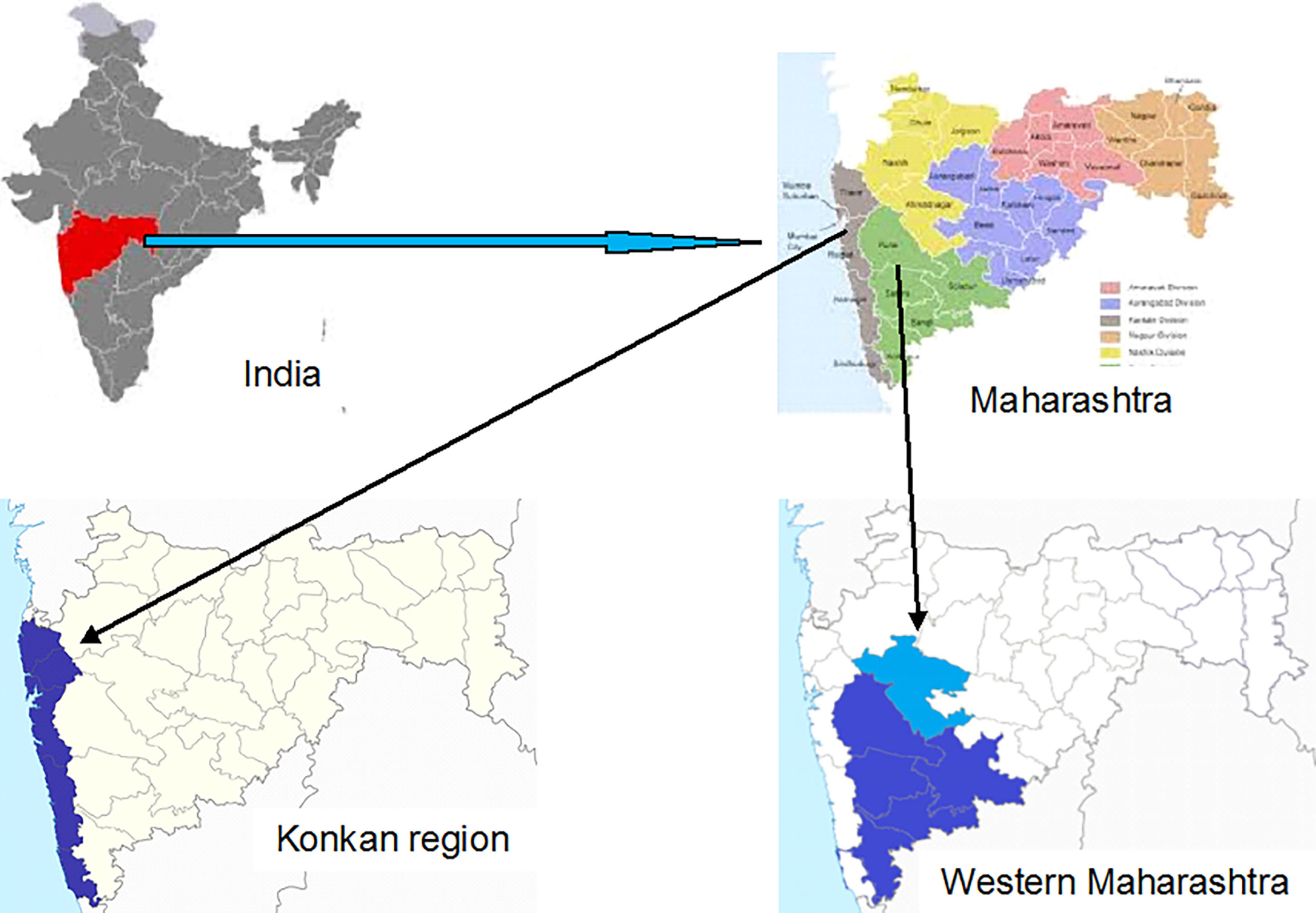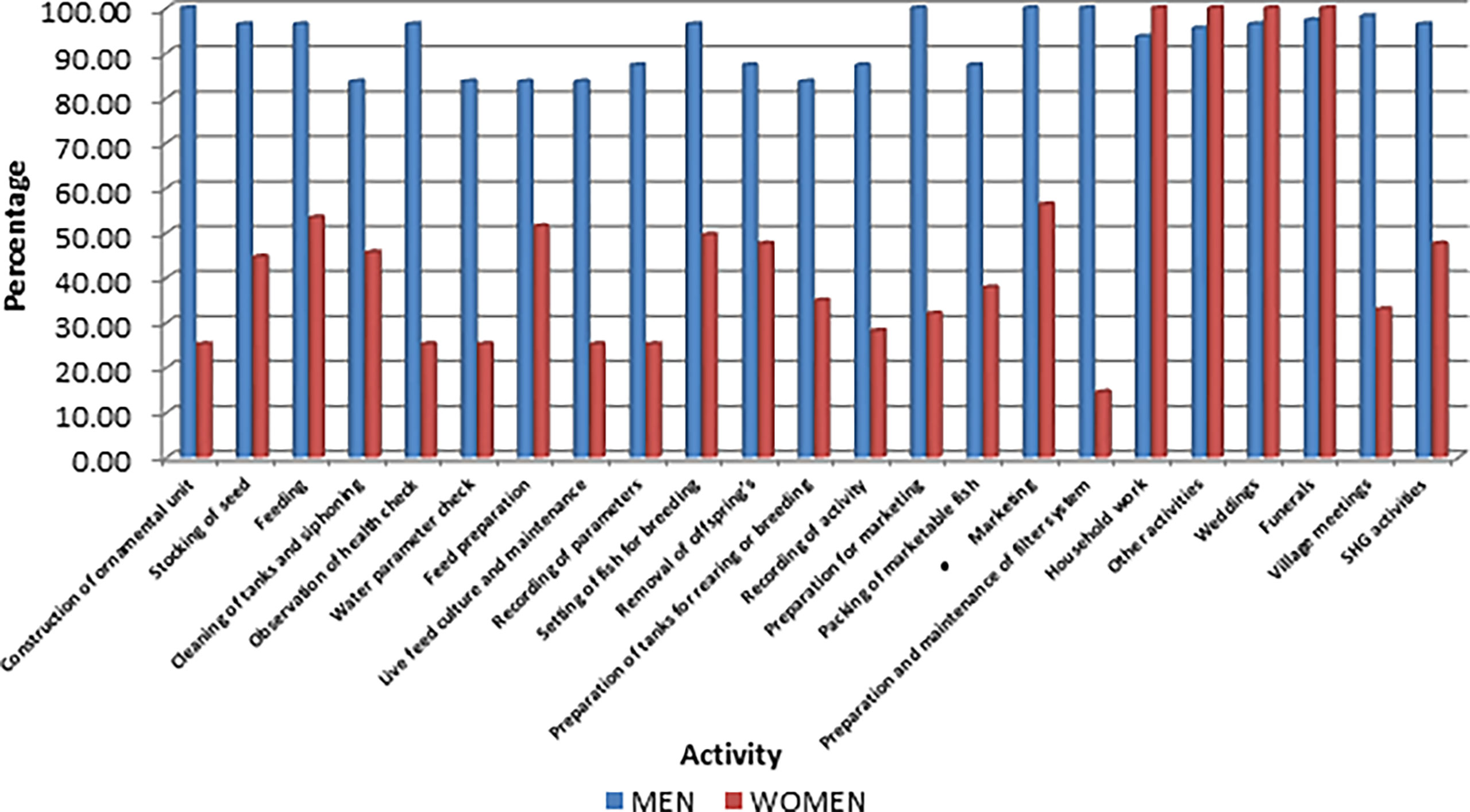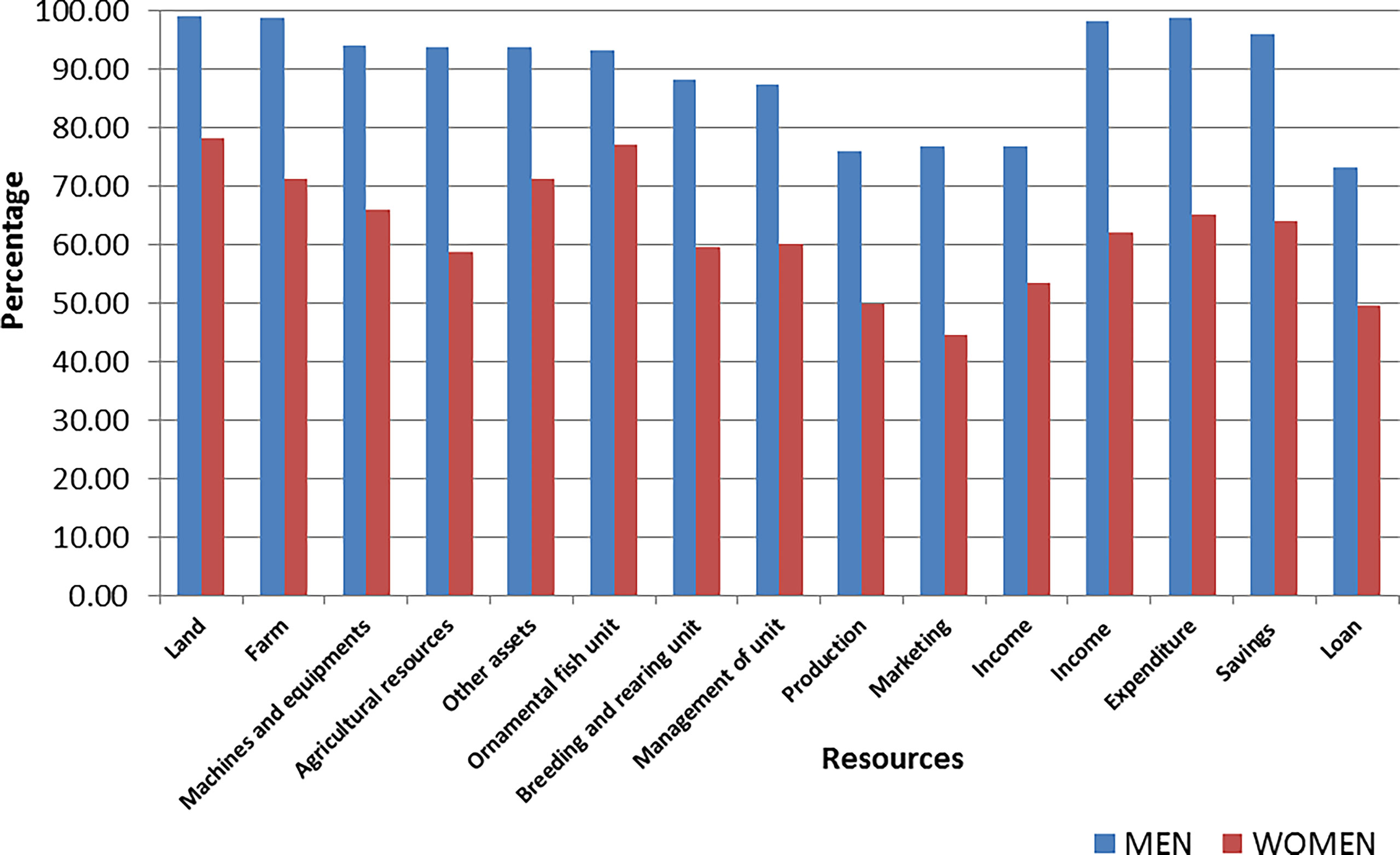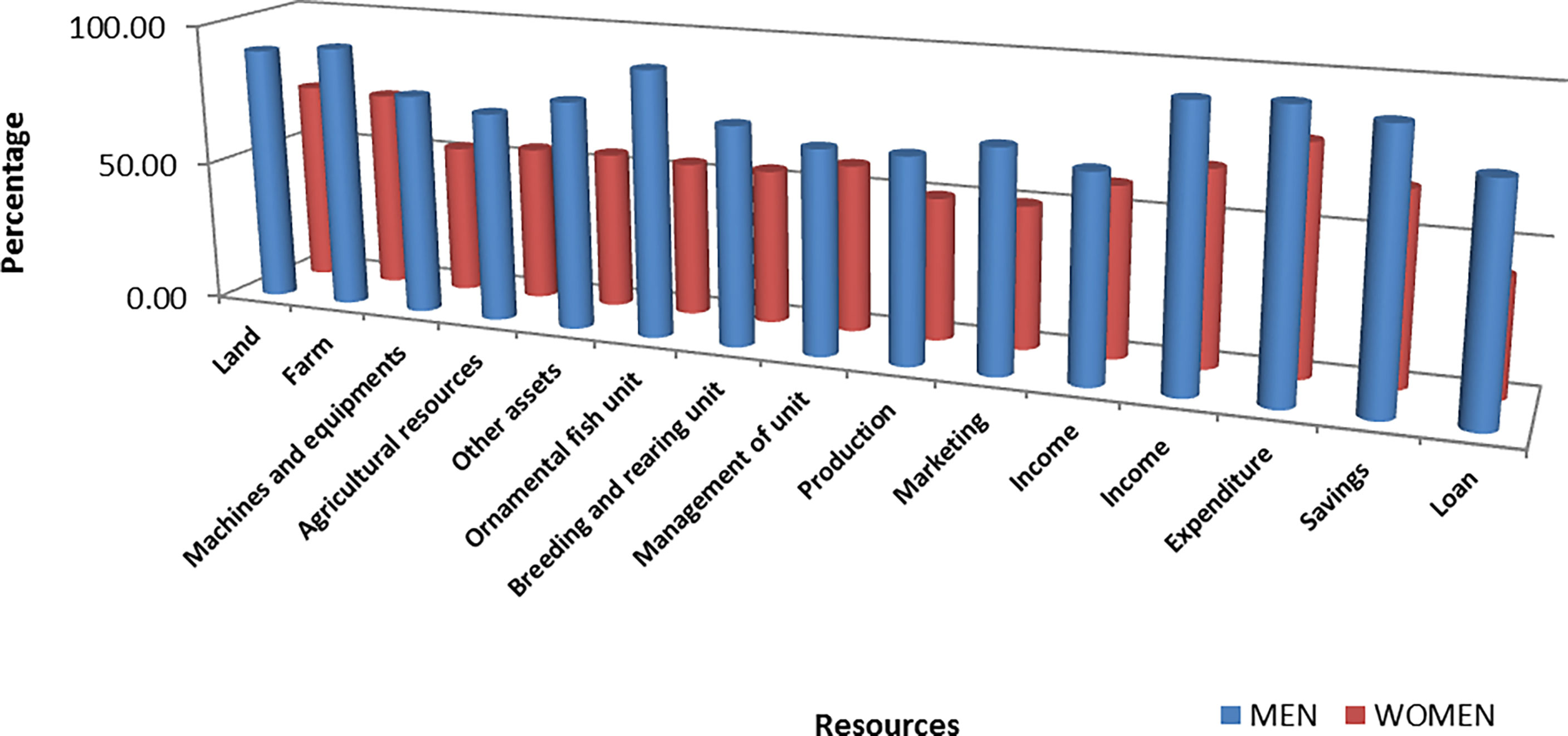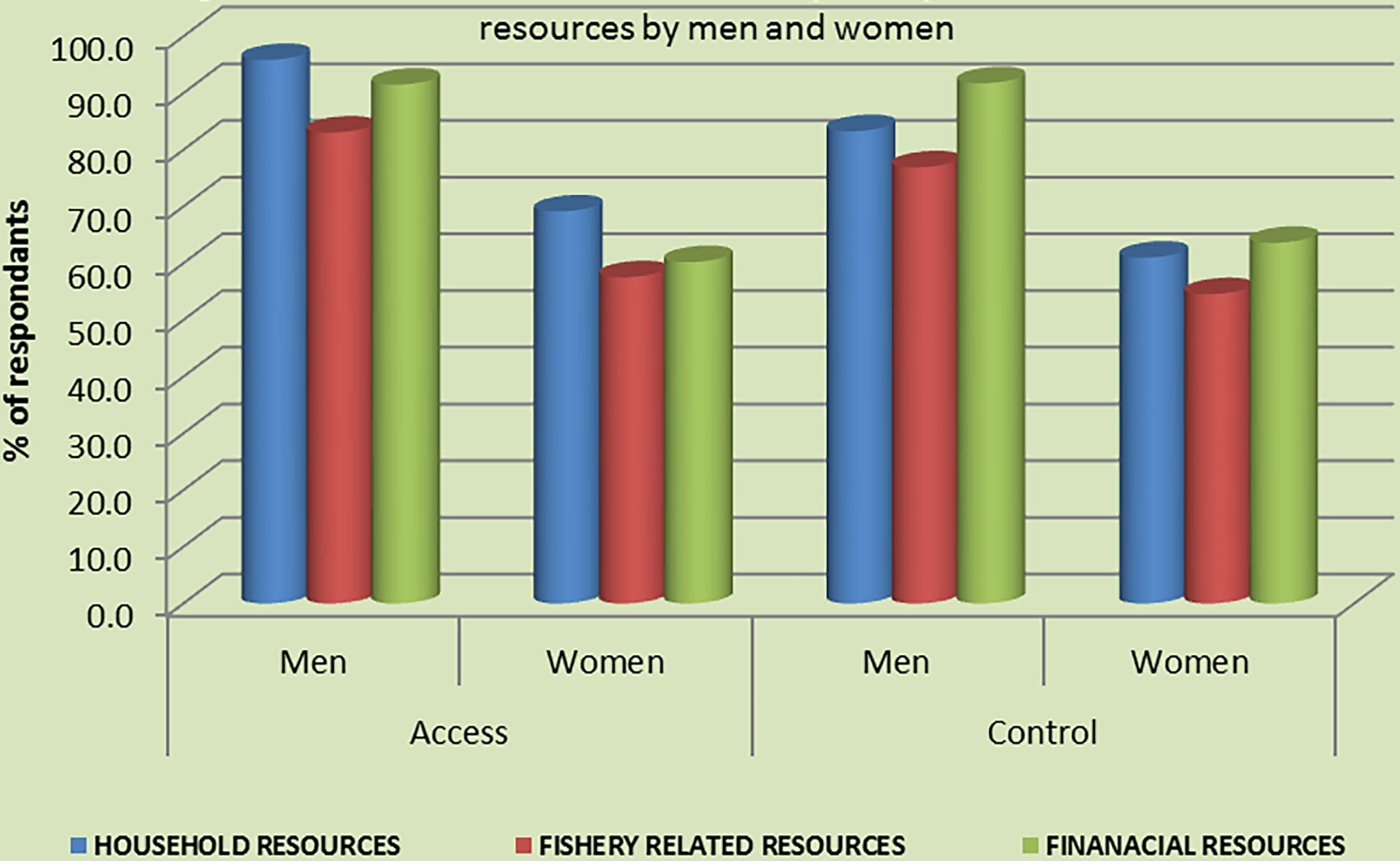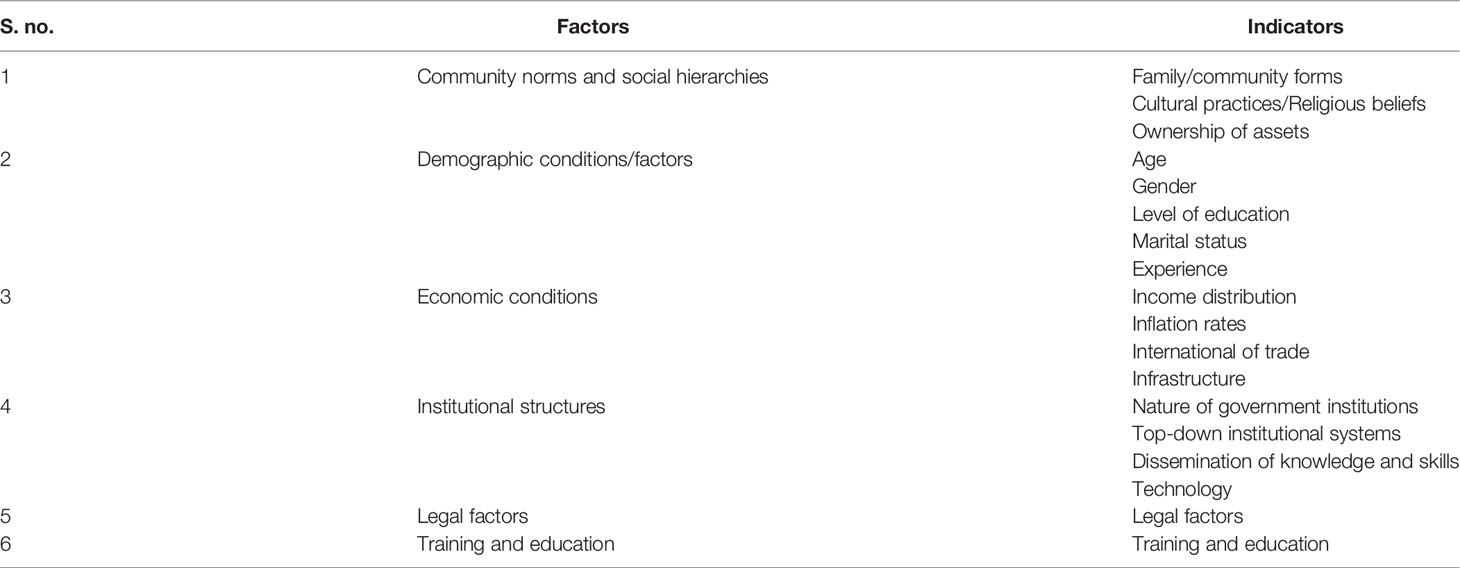- 1College of Fisheries, Dr. Balasaheb Sawant Konkan Agricultural University (DBSKKV), Ratnagiri, India
- 2Indian Council of Agricultural Research (ICAR), Central Institute of Fisheries Education (CIFE), Mumbai, India
Ornamental fisheries are an emerging business and offer vast opportunities. In India, the Maharashtra state had a scheme called “Rainbow Revolution”, which was started to encourage breeding and export of ornamental fishes. Taking advantage of this scheme, 305 male and female entrepreneurs took up this small-scale business. Gender analysis, which provides the necessary data and information to integrate a gender perspective into policies, programs, and projects and allows for the development of interventions that address gender inequalities, was conducted using the Harvard Analysis Framework for male and female entrepreneurs involved in ornamental fish production. The objectives were to explore factors that influenced entrepreneurs to take up this business and to map the activity, access, and control profile of male and female entrepreneurs involved in ornamental fish production. Out of 305 ornamental production units under the Rainbow Revolution scheme, 110 units were studied, of which 82 were owned by men and 28 were owned by women. Factors that influenced both men and women to pursue this business were community norms, prevailing social hierarchy, demographic factors, and access to special training. Activity profile revealed that men were involved in the construction of ornamental fish production unit, observation and checking fish health, checking water parameters, live food culture, marketing, upkeep, and maintenance, and it was found that they spent an average of 8 h/day on these activities. Women were involved in fish feeding, cleaning of tanks, siphoning, feed preparation, and marketing, spending an average of 4 h/day. Many activities like feeding, cleaning of tanks and siphoning, feed preparation, setting of fish for breeding, removal of offspring, and marketing were performed by both. Men had higher access and control on resources like land, farm, machine, equipment, and finances. The Mann–Whitney U test revealed a statistically significant difference between men and women’s access and control on resources. A study has revealed that in addition to family and house responsibilities, women spent 4 h/day on this business. They have less access and control on resources because of the existing power relations with which we conclude that men and women cannot be treated as homogeneous categories when designing any schemes/policy interventions.
1 Introduction
Ornamental fish breeding, rearing, and production have become emerging and lucrative aquaculture ventures. With the increase in demand for ornamental fishes especially in USA, Europe, and Japan, many countries in Asia have started a small-scale business of culturing beautifully colored ornamental fishes. Developing countries play an important role in this industry, and estimates show that nearly 60% of the international trade in ornamental fish originates from developing countries mainly from Asia (FAO, 2006; Raja et al., 2019).
The government of India has identified the ornamental fish sector as one of the thrust areas as a small-scale fishery activity for generating employment opportunities and export. The government of India launched a scheme called “Rainbow Revolution” for the development of export-oriented ornamental fish industry in India with a mandate to encourage the breeding and export of fish (MPEDA, 2011).
The scheme was implemented in 3 stages/grades. Grade I was for cluster-based rearing, Grade II was for breeding and rearing, and Grade III was for breeding, rearing, and export. The Grade I scheme was more popular in women as it is based on the ornamental fish rearing aspects and is cluster based. The Marine Products Export Development Agency (MPEDA) implemented the scheme and provided 50% subsidy for establishing ornamental units, along with 3 to 5 days training on ornamental fish breeding and rearing. The scheme was initially implemented in 4 states, i.e., Maharashtra, West Bengal, Tamil Nadu, and Rajasthan, and later extended to other states.
About 45% of the world’s population depends on agriculture, forestry, fishing, or hunting for their livelihood, of whom women constitute 43% of the agricultural labor force worldwide, producing a large portion of the world’s food crops (Nag et al., 2012; FAO, 2018). Studies by Swain et al. (2013); Rameshan and Saktivel (2014), and Yadav and Sharma (2017b) have reported that this business is being promoted among women groups for livelihood security. The role of women in ornamental fisheries has been reported in the state of West Bengal where women perform feeding, the collection of live food, and the selling of ornamental fishes to retailers (Ghosh et al., 2003; Yadav and Sharma, 2017a). In Odisha, ornamental fish breeding and farming as a backyard activity have been taken up, especially in rural areas (Swain et al., 2011). It has been reported that in Maharashtra, women are spending half of the time spent by men in ornamental fish production (Yadav and Sharma, 2017a).
Gender analysis of the ornamental fisheries sector can help in understanding the different contribution of women and men to production and value addition within the sector, as well as how men and women might use and make decisions differently on the natural resources where their livelihood depends on. There are few studies on the role of women in small-scale ornamental fish production, but detailed studies related to gender analysis are not reported. Therefore, a study was done with the objective of mapping the activity, access/control profile, and influencing factors in small-scale ornamental fish production units in Maharashtra, India.
2 Materials and Methods
2.1 Study Area
The location of the study (Figure 1) was the Maharashtra state in India, in which districts with higher numbers of freshwater ornamental fish producers/entrepreneurs were categorized into four groups, namely, Thane-Mumbai, Ratnagiri, Sindhudurg, and other districts of Maharashtra. There are a total of 305 ornamental fish producers/entrepreneurs who have taken up this small-scale business, and for the study, 110 were randomly selected, of whom 82 were men and 28 were women.
To achieve the objectives of the study, the Harvard Analytical Framework provided by Overholt et al. (1985) was used. The Harvard Analytical Framework is a grid for collecting data at the micro-level (i.e., at the community/household level). It is a useful way of organizing information and can be adapted to many situations. The framework has three main tools, i.e., Activity Profile, Access and Control Profile, and Influencing factors. Questions related to these three tools were prepared in an interview schedule and pilot testing was done.
2.2 Harvard Tool 1: The Activity Profile
This tool identifies all relevant productive and reproductive tasks and answers the question: Who does what? In the present study, the participation of women and men and time spent on each activity in the ornamental fish production along with other productive and reproductive tasks were documented.
Productive activities included one-time activities like construction of ornamental fish production unit and seed stocking, and daily activities like feeding, cleaning of tanks and siphoning, observation of health check, water parameter check, feed preparation, live feed culture and maintenance, recording of parameters, setting of fish for breeding, removal of offspring, preparation of tanks for rearing or breeding, recording of activity, preparation for marketing, packing of marketable fish, marketing, reparation, and maintenance of the filter system. Reproductive activities included household work (cooking and cleaning), caring, education and teaching, and personal/leisure time; social and community activities included social, political, and community activities.
2.3 Harvard Tool 2: The Access and Control Profile
This tool helps to list what resources the ornamental fish producers use to carry out the tasks identified in the activity profile. It indicates whether women or men have access to resources, who controls their use, and who controls the benefits of a household’s use of resources. It is to be noted that access means that you are able to use a resource, but this says nothing about whether you have control over it. For example, women may have some access to local political processes but little influence or control over which issues are discussed and the final decisions. The person who controls a resource is the one ultimately able to make decisions about its use, including whether it can be sold. Based on this, in the present study, access and control to household resources, fisheries resources, and financial resources in the ornamental fish production of women and men were documented.
Household resources included land, farm, machine, equipment, and other household assets. Fisheries resources included ornamental fish unit, breeding and rearing unit, management of the unit, production, marketing, and income resources. Financial resources included income, expenditure, savings, and credit. To study the access and control profile of the ornamental fish producers, a three-point scale, i.e., low (0), medium (1), and high (2), was used.
2.4 Harvard Tool 3: Influencing Factors
This tool allows listing the factors that influence the differences in the gender division of labor, access, and control as listed in the activity profile and access and control profile. Identifying past and present influences can give an indication of future trends. These factors must also be considered because they present opportunities and constraints to increasing the involvement of women in development projects and programs. Influencing factors include all those that shape gender relations, and determine different opportunities and constraints for men and women.
The influencing factors were identified as community norms and social hierarchies’ demographic conditions/factors, economic conditions, institutional structures, legal factors, and training and education of the ornamental fish production, and these were documented.
2.5 Statistical Analysis
The Mann–Whitney U-test was used to check if there was a statistically significant difference between men and women for activity profile and access and control profile.
The working formula for the Mann–Whitney U-test as given by Snedecor and Cochran (1967) was used.
where
U1 = Mann–Whitney statistic for group 1
U2 = Mann–Whitney statistic for group 2
n1 = number of samples in group 1
n2 = number of samples in group 2
R1 and R2 = sum of ranks in group 1 and group 2, respectively
The t-test is a parametric test based on Student’s t distribution, which is derived from the parent normal distribution. Its value ranges from (-) ∞ to (+) ∞. This test is used when the sample size is <{{3sp/}}0. In the present study, it is used to test whether there is any difference between men and women in productive, reproductive, and socio-political activities, checked for statistical significance. The working formula for the Mann–Whitney U-test as given by Snedecor and Cochran (1967) was used.
where
- m is the sample mean
- n is the sample size
- s is the sample standard deviation with n − 1 degrees of freedom
- μ is the theoretical mean
3 Results and Discussion
3.1 Tool 1: Activity Profile
The involvement of men and women in productive activities, reproductive activities, and social and community activities as per the Harvard Analytical Framework was determined. The participation and number of hours spent in productive activities, reproductive activities, and social and community activities as per the Harvard Analytical Framework are presented in Table 1.
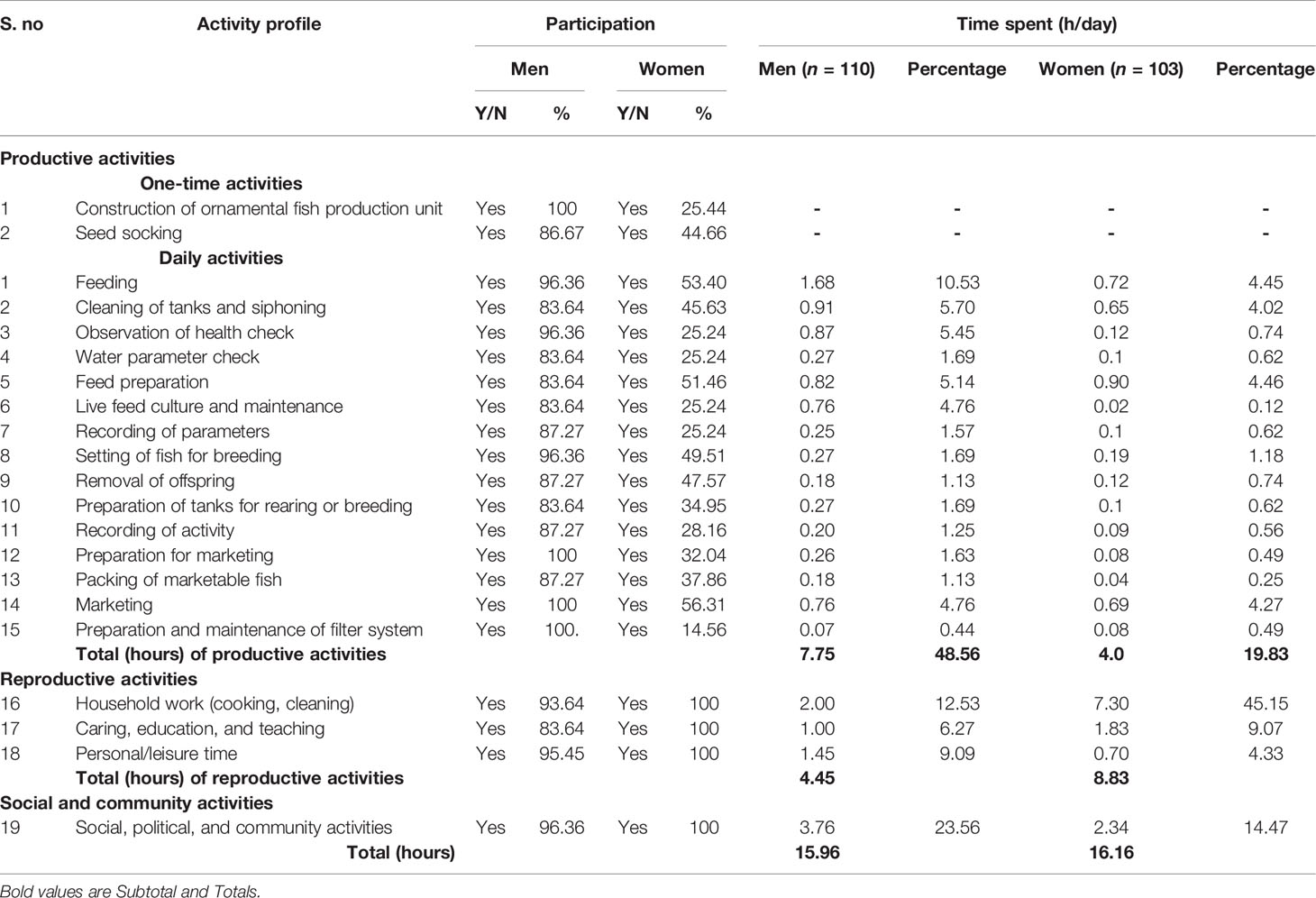
Table 1 Participation and time spent (h/day) by men and women in productive activities, reproductive activities, and social and community activities.
3.1.1 Productive Activities
From Table 1, it is clear that participation of men was higher in productive activities including both one-time and daily activities. In one-time activity, like the construction of ornamental fish production unit, men’s participation was 100% as compared to women’s participation of 25.44%. In seed socking, men’s participation was 86.67%, whereas women’s participation was 44.66%. With respect to daily activities of the ornamental fish production unit like feeding, cleaning of tanks and siphoning, observation of health check, water parameter check, feed preparation, live food culture and maintenance, recording of parameters, setting of fish for breeding, removal of offspring, preparation of tanks for rearing or breeding, recording of activity, preparation for marketing, packing of marketable fish, marketing preparation, and maintenance of the filter system, the participation of men ranged from 83.64% to 100%, whereas for women, participation was higher in activities like feeding (53.40%), cleaning of tanks and siphoning (49.51%), feed preparation (51.46%), setting of fish for breeding (53.33%), removal of offspring (47.57%), and marketing (56.31%).
3.1.2 Reproductive/Domestic Activities
In reproductive/domestic activities, the participation of women was higher than that of men. Women’s participation in household work like cooking and cleaning, caring, education/teaching, and personal work/leisure time was 100%, and other work like personal activities was 100%, whereas men’s participation in household work, caring, education/teaching, and personal work/leisure time was less as compared to women.
3.1.3 Social and Community Activities
In social and community activities, the participation of men was higher than women. The participation of men in social and community activities like weddings, funerals, village meetings, and self-help group (SHG) activities was 96.36%, 97.27%, 98.18%, and 96.36%, respectively, whereas women’s participation in weddings and funerals was 100%, but their participation in village meetings and SHG activities was 33.01% and 43.57%, respectively. The activity profile (participation) of men and women is depicted in Figure 2.
From Table 1, it is also clear that men spent 7.75 h/day on average towards management of ornamental fish production units, whereas women’s involvement was found to be 4 h/day on average. Men were spending more time per day on feeding, cleaning and siphoning, observation of health checks, feed preparation, live feed culture and maintenance, and marketing. Women were spending more time per day in productive activities of ornamental fish production like feeding, cleaning and siphoning, feed preparation, and marketing.
In reproductive activities like cooking, cleaning, caring, and personal work, women’s involvement was significantly higher as compared to men. Women spent about 54.73% of the time, i.e., 8.85, h in reproductive activities like cooking, cleaning, caring, and personal work, whereas men’s involvement was restricted to 15.69% of the time, i.e., 2.51, h in reproductive activities.
In social and community activities, time spent by men and women was 23.56% and 14.47%, respectively. Men spend more time on all the activities of social and community activities like weddings, funerals, village meetings, and SHG activities, whereas women spent most of the time in weddings and funerals and less time in village meetings and SHG activities, and their participation was also limited. The time in hours spent in productive activities, reproductive activities, and social and community activities is depicted in Figures 3 and 4.
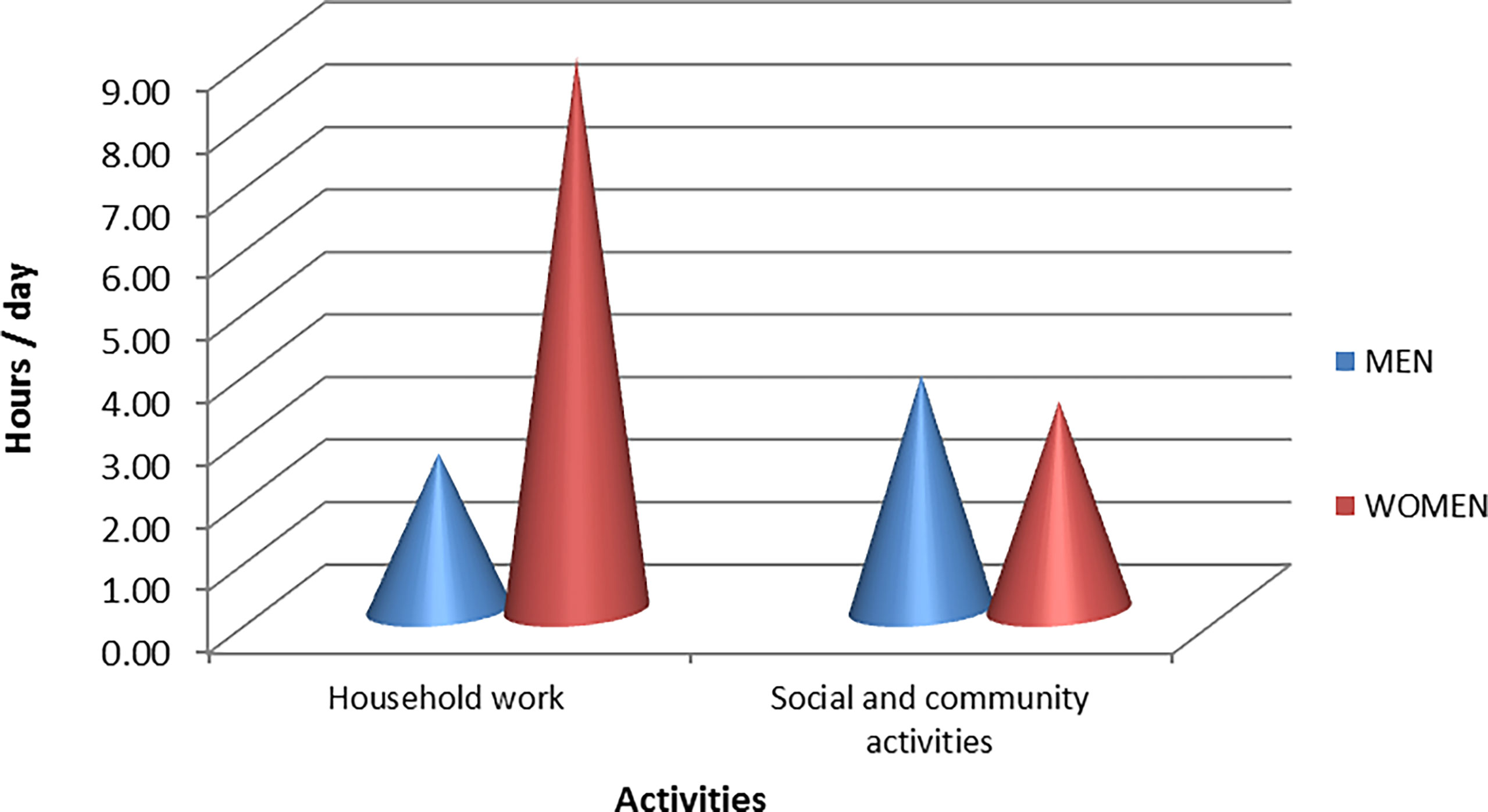
Figure 4 Activity profile (time spent) of men and women on reproductive, social, and community activities.
The difference between the time spent in productive, reproductive, and socio-political activities by men and women was tested by Mann–Whitney U-test. The significance level was set as 0.05 (α). Comparing the p-value with the test statistic value, the decision was made. If the p-value is less than or equal to α, the null hypothesis was rejected in favor of the alternative hypothesis. The results of the Mann–Whitney U-test are presented in Table 2.

Table 2 Comparison between productive, reproductive, social, and community activities performed by men and women.
It is clear from Table 2 that there was a significant difference between men and women regarding time spent in productive, reproductive, and social and community activities.
3.1.4 Difference Between Productive, Reproductive, Social, and Community Activities by Men and Women
The difference between men and women in productive, reproductive, and socio-political activities was checked for statistical significance by t-test. The significance level was set as 0.05 (α). Comparing the p-value with the test statistic value, the decision was made. If the p-value was less than or equal to α, the null hypothesis was rejected in favor of the alternative hypothesis. The results of the t-test are presented in Table 3.

Table 3 Comparison between the men and women in time spent for ornamental fish business and household activities.
It is clear from Table 3 that there was a significant difference between time spent by men and women in productive, reproductive, social, and community activities. In productive activities of ornamental fish production, men spent approximately 7.75, h whereas women spent 4<nb.sp/>h
In reproductive work, women spent more time than men in household, care, and personal work. Women spent 8.83 hand men spent 4.45 hin reproductive work. In social and community activities, men spent approximately 3.76 hin ornamental fish production work, whereas women spent 2.34 hin the same work.
Seila et al. (2016) studied the role of gender in the development and adoption of small-scale aquaculture in Cambodia. They observed that female and male farmers undertook different activities. They concluded that men were mainly involved in construction, changing water, and pumping of water for harvest; otherwise, the majority of the activities were carried out by women, including making supplementary feed, feeding, harvesting, and marketing.
Similar studies in the field of fisheries reported by Das and Khan (2016) and Ahmed (2009) indicated that women in Bangladesh were involved in specific activities related to fish production, such as stocking ponds, feed preparation, feeding, pond supervision and management, fertilization, liming, and harvesting fish for home consumption, as well as sorting, cleaning, and grading fish for the market. A study by Shirajee et al. (2010) has reported their role in post-harvest activities.
3.2 Tool 2: Access and Control Profile
Men and women’s access and control over the resources are essential to ensuring their right to equality and to an adequate standard of living. In many communities, gender disparities with regard to land and other productive resources are linked to assumptions that men, as the head of the household, control and manage productive resources (UNHR, 2013). Unequal access to resources limits women’s capacity to ensure agricultural productivity, security of livelihoods, and food security and is increasingly linked to poverty, migration, and urbanization (DESA, 2009). Keeping this in mind, this study was done to analyze the extent of access and control over resources by men and women in ornamental fish enterprises. Access and control of men and women over household resources, fisheries resources, and financial resources were studied.
The access over household, fisheries, and financial resources of men and women is depicted in Figure 5. It is clear from Figure 5 that men’s access over resources was higher for households, fishery, and financial resources. Men’s access to household resources like land, farm, machine, equipment, and other household assets was significantly higher than that of women. Access to fishery-related resources including ornamental fish unit, breeding and rearing unit, and management of the unit was 90%, and access to production, marketing, and income resources was 76.5%.
Figure 5 also indicates that women’s access to resources was relatively less for households, fisheries, and financial resources. Women’s access over household resources was less even when the time spent by them in household work was higher. Women’s access to household resources like land, farm, machine, equipment, and other household assets was 70%, which was significantly less than that for men. Access to fishery-related resources including ornamental fish unit, breeding and rearing unit, management of the unit, production, marketing, and income resources was 57%. Access to financial resources like income, expenditure, and savings was 63.75%, but access to loan was less at 49.51%.
Control over household, fisheries, and financial resources of men and women are depicted in Figure 6. It is clear from Figure 6 that the control of men over household, fisheries, and financial resources was higher. Control on household resources like land, farm, machine, equipment, and other household assets was significantly high, at 83%. Access to fisheries resources including access to ornamental fish unit, breeding and rearing unit, management of the unit, production, marketing, and income resources was 76.89% for men. Control on financial resources like income, expenditure, and savings and loan was also very high for men (91.70%). In the case of women, control over resources was relatively lower for households, fisheries, and financial resources. Control on household resources like land, farm, machine, equipment, and other household assets was 61.97% for men.
Control over fishery-related resources including control on ornamental fish unit, breeding and rearing unit, management of the unit, production, marketing, and income resources was 54.53% for women. Control on financial resources like income, expenditure, and savings and loan was 63.59%. The access and control over household resources and fishery resources of men and women are depicted in Figure 7. The difference between access and control over resources by men and women was checked for statistical significance by the Mann–Whitney U test and is presented in Table 4.
It is clear from Table 4 that there was a significant difference between men and women’s access and control over resources. On average, men have higher access to resources (89.55%) than women (62.10%). Men also have higher control on resources (82.97%) than women (59.09%).
The results obtained were similar to other studies, which have also stated that men usually have more access and control over resources related to agriculture land; farm assets; inputs such as improved seeds, fertilizers, and insecticides; management of labor; management of cash; and procuring and repaying loan (Gupta and Jain, 2011 and Paul and Rani, 2016).
3.3 Tool 3: Influencing Factors
In this section, factors that influence the differences in gender roles and access and control over resources are analyzed. Institutional factors as per the Harvard Analytical Framework (Overholt et al., 1985) are community norms and social hierarchy, demographic factors, institutional structures, economic factors, political factors, legal parameters, and trainings. These factors are defined as the factors that influence the differences in the gender division of labor, access, and control. These factors must also be considered because they present opportunities and constraints to increasing the involvement of women in ornamental fish production.
The six factors that influence the participation of men and women to undertake and run the ornamental fish production are presented in Table 5. These influencing factors were perceived as opportunity/constraint by men and women, and the same is presented in Table 6.
3.4 Influencing Factors as Constraints
From Table 6, it is observed that for both men and women, the main influencing factors were training and education, community norms, social hierarchy, and demographic conditions. About 76.70% of women considered community norms and social hierarchy as influencing factors for participation as well as access and control of resources, whereas 56.36% of men considered community norms and social hierarchy as influencing factors for participation, access, and control. Men were the head of the household and owned household resources like farm land and income. It was reported that, initially, trainings also were given to the head of the households.
In a study by Owitti (2015), it has been reported that the main influencing factors were household headship, top-down institutional systems, property ownership and collateral, work burden/load, illiteracy, culture/tradition, poverty, and poor infrastructure in agricultural households in Ethiopia. He also stated that women were engaged in unpaid reproductive roles, have more work burden, and faced many demographic, social, economic, cultural, and institutional constraints as compared to men.
About 67.27% of men and 59.22% of women considered training and education as influencing factors for their participation in ornamental fish production. Yadav et al. (2017d) also reported that lack of special trainings on ornamental fish, non-availability of technical advice, and lack of updated information were major constraints faced by the ornamental fish production sector. Demographic factors such as gender, age, occupation, education, marital status, and experience were important influencing factors. Demographic factors being an influencing factor was reported by 42.73% men and 39.81% of women.
Paul et al., (2017) has also reported that gender, age, formal education, marital status, and income per month were the socio-economic determinants affecting the participation of men and women in the fisheries value chain in Nairobi city county.
3.5 Influencing Factors as Opportunity
From Table 6, it is observed that the main influential factors that can be converted as an opportunity were institutional structures for both men and women. About 50.49% of women and 55.45% of men reported that they consider institutional structures as influencing factors for the development of ornamental fish production. It was found that a number of government organizations, such as MPEDA; Indian Council of Agricultural Research-Central Institute of Fisheries Education, Mumbai; College of Fisheries, Ratnagiri; Krishi Vigyan Kendra; and Fisheries Research Stations, were involved in ornamental fish production and export by helping the entrepreneurs in terms of providing technical knowledge, training, and guidance. It is clear that among the influencing factors, institutional structures, demographic factors, and trainings can be opportunities for both men and women for the development of ornamental fish production enterprise.
Similar results have been reported by many researchers in that ornamental fish production can be a very good homestead business, which has been successful in West Bengal and Kerala states (Swain et al., 2011; Jayalal et al., 2016; Yadav et al., 2017c).
4 Conclusion
The study on activity profile revealed that men were involved in the construction of the ornamental fish production unit, observation and checking fish health, checking water parameters, live food culture, marketing, upkeep, and maintenance. Their participation in this business on average was 8 h/day. Women were involved in fish feeding, cleaning of tanks, siphoning, feed preparation, and marketing, with a participation of 4 h/day on average. There was an overlap in a few activities. Men had higher access and control on resources like land, farm, machine, equipment, and finances. The Mann–Whitney U-test revealed a statistically significant difference between men and women’s access and control on resources. Factors that influenced both men and women to pursue this business were community norms, prevailing social hierarchy, demographic factors, and access to special training. The study has revealed that in addition to family and house responsibilities, women spend 4 h/day on this business. Still, they have less access and control on resources because of existing power relations with which we conclude that complexities in community cannot be ignored and men and women cannot be treated as homogeneous categories when designing policy interventions. From the study, it is suggested that women’s ownership could be increased by having targeted schemes and trainings for women in the field of ornamental fish production. Based on the study, it is suggested that women can take up this entrepreneurial activity by forming SHGs. This will make the ornamental fish production enterprise more equitable and sustainable.
Data Availability Statement
The original contributions presented in the study are included in the article/supplementary material. Further inquiries can be directed to the corresponding author.
Author Contributions
All authors listed have made a substantial, direct, and intellectual contribution to the work and approved it for publication.
Conflict of Interest
The authors declare that the research was conducted in the absence of any commercial or financial relationships that could be construed as a potential conflict of interest.
Publisher’s Note
All claims expressed in this article are solely those of the authors and do not necessarily represent those of their affiliated organizations, or those of the publisher, the editors and the reviewers. Any product that may be evaluated in this article, or claim that may be made by its manufacturer, is not guaranteed or endorsed by the publisher.
Acknowledgments
The authors would like to thank ICAR-CIFE, Mumbai, and Dr. Balasaheb Sawant Konkan Agricultural University, Dapoli, for providing support. Thanks are due to all ornamental fish producers who provided information for the study.
Abbreviations
ICAR, Indian Council of Agricultural Research; CIFE, Central Institute of Fisheries Education; DBSKKV, Dr. Balasaheb Sawant Konkan Agricultural University; MPEDA, Marine Product Export Development Authority; UNHR, United Nations Human Rights; DESA, Department of Economic and Social Affairs; SPSS, Statistical Package for Social Sciences; SHG, Self-Help Group; FAO, Food and Agricultural Organization.
References
Ahmed N. (2009). Revolution in Small-Scale Freshwater Rural Aquaculture in Mymensingh, Bangladesh. World Aquacult. 40 (4), 31–35.
Das J., Khan M. S. (2016). Women and Aquaculture in Bangladesh: The Unpaid Labour. Banglad. E-Journ. Sociol. 13 (1), 115–125.
DESA (2009). United Nations, Department of Economic and Social Affairs, Population Division. International Migration Report 2009: A Global Assessment (United Nations, ST/ESA/SER.A/316).
FAO (2006). Fishstat Plus: Universal Software for Fishery Statistical Time Series (Rome, Italy: Fisheries Department, Food and Agricultural Organization of United Nations). Available at: www.fao.org/fi/statist/FISOFT/FISHPLUS.asp.
FAO (2018). The State of World Fisheries and Aquaculture: Meeting the Sustainable Development Goals (Rome: FAO).
Ghosh A., Mahapatra B. K., Datta N. C. (2003). Ornamental Fish Farming – Successful Small Scale Aqua Business in India. Aquacult. Asia. 8 (3), 14–16.
Gupta M., Jain S. (2011). Access and Control of Gender of District Ganganagar Over Agriculture Resources. Adv. Res. J. Soc. Sci. 2 (2), 217–220.
Jayalal L., Sruthi P., Nikita G. (2016). Workspace of Women in the Small-Scale Ornamental Fish Value Chain in Kerala. Asian Fish. Sci. Spec. Issue. 29S, 213–222.
MPEDA (2011). Guidelines for Green Certification of Freshwater Ornamental Fishes (Kochi, Kerala: Marine Product Export Development Authority (MPEDA), 122 pp.
Nag A., Vyas H., Shah P., Nag P. K. (2012). Risk Factors and Musculoskeletal Disorders Among Women Workers Performing Fish Processing. Am. J. Ind. Med. 55 (9), 833–843. doi: 10.1002/ajim.22075
Overholt C., Anderson M. B., Cloud K., Austin J. E. (1985). Gender Roles in Development Projects. A Case Book (West Hartford, USA: Kumarian Press).
Owitti O. L. (2015). Gender Differences and Relations in Rural Household Livelihoods of Gog District, Anywaa Zone, Gambella Region, South Western Ethiopia. Int. J. Gender. Women’s. Stud. 3 (1), 51–79. doi: 10.15640/ijgws.v3n1a7
Paul M., Rani R. (2016). Gender Differences in Access to and Control Over Farm Resources. Int. J. Home. Sci. 2 (2), 301–302.
Paul K., Elishiba K., Mildred L. (2017). Socio-Economic Determinants of Men and Women’s Participation in Fisheries Value Chain in Nairobi City County. Kenya. J. Scientific Eng. Res. 4 (4), 91–98.
Raja K., Anand P., Padmavathy S., Sampathkumar J. S. (2019). Present and Future Market Trends of Indian Ornamental Fish Sector. Int. J. Fish. Aquat. Stud. 7 (2), 06–15.
Rameshan B., Sakthivel R. (2014). The Role of Women in the Popularization of Ornamental Fish Culture in Kerala. Intercontinent. J. Market. Res. Rev. 2 (11), 54–70.
Seila A., Kwasek K., Tsatsaros J., Gareth J. (2016). The Role of Gender in the Development and Adoption of Small-Scale Aquaculture: Case Study From Northeast Cambodia. Asian Fish. Sci. Spec. Issue. 29S, 111–126.
Shirajee S. S., Salehin M. M., Ahmed N. (2010). The Changing Face of Women for Small-Scale Aquaculture Development in Rural Bangladesh. Aquacult. Asia. Magaz. 15 (2), 9–16.
Snedecor G. W., Cochran W. G. (1967). Statistical Methods. Sixth Edition (New Delhi: Oxford and IBH Publishing Co.), 593 pp.
Swain S. K., Baliarsingh B. K., Sahoo S. K., Meher P. K., Patro B., Rajesh N., et al. (2013). A Success Story of MaaTarini Self Help Group Ornamental Fish Unit, Purunia Village, Keonjhar District, Odisha, India. Aquacult. Asia. 18 (2), 21–24.
Swain S. K., Ikmal S. S., Parida S., Patro B., Sahoo S. K., Rajesh N., et al. (2011). Success Story of Barakhandapat Ornamental Fish Breeding Unit at Patna Cluster of Keonjhar, Odisha. India. Aquacult. Asia. 16 (4), 11–13.
UNHR (2013). Realizing Women’s Rights to Land and Other Productive Resources (New York and Geneva: Office of the United Nations High Commissioner for Human Rights).
Yadav B., Sharma A. (2017a). Gender Roles Analysis of Ornamental Fish Enterprises in Maharashtra State, India. Asian Fish. Sci.: Spec. Issue. 30S, 333–342. doi: 10.33997/j.afs.2017.30.S1.020
Yadav B., Sharma A. (2017b). Livelihood Analysis of Ornamental Fish Producers in Mumbai and Thane Districts of Maharashtra State. Asian J. Agric. Exten. Econom. Sociol. 17 (4), 1–9. doi: 10.9734/AJAEES/2017/33965
Yadav B., Sharma A., Ojha S. N., Shirdhankar M. M., Pai R. (2017c). Socio-Economic Profile of Ornamental Fish Producers in Maharashtra State, India. J. Indian Fish. Assoc. 44 (1), 69–76.
Keywords: ornamental fish, gender analysis, access and control, Harvard Analysis Framework, Maharashtra
Citation: Yadav B and Sharma A (2022) Gender Analysis of Ornamental Fish Production Units in Maharashtra, India. Front. Mar. Sci. 9:907069. doi: 10.3389/fmars.2022.907069
Received: 30 March 2022; Accepted: 11 May 2022;
Published: 16 June 2022.
Edited by:
Archana Sinha, Central Inland Fisheries Research Institute (ICAR), IndiaReviewed by:
Ajith Kumar T T, National Bureau of Fish Genetic Resources (ICAR), IndiaAparna Roy, Central Inland Fisheries Research Institute (ICAR), India
Copyright © 2022 Yadav and Sharma. This is an open-access article distributed under the terms of the Creative Commons Attribution License (CC BY). The use, distribution or reproduction in other forums is permitted, provided the original author(s) and the copyright owner(s) are credited and that the original publication in this journal is cited, in accordance with accepted academic practice. No use, distribution or reproduction is permitted which does not comply with these terms.
*Correspondence: Arpita Sharma, YXJwaXRhc2hhcm1hQGNpZmUuZWR1Lmlu
 Bharat Yadav
Bharat Yadav Arpita Sharma
Arpita Sharma